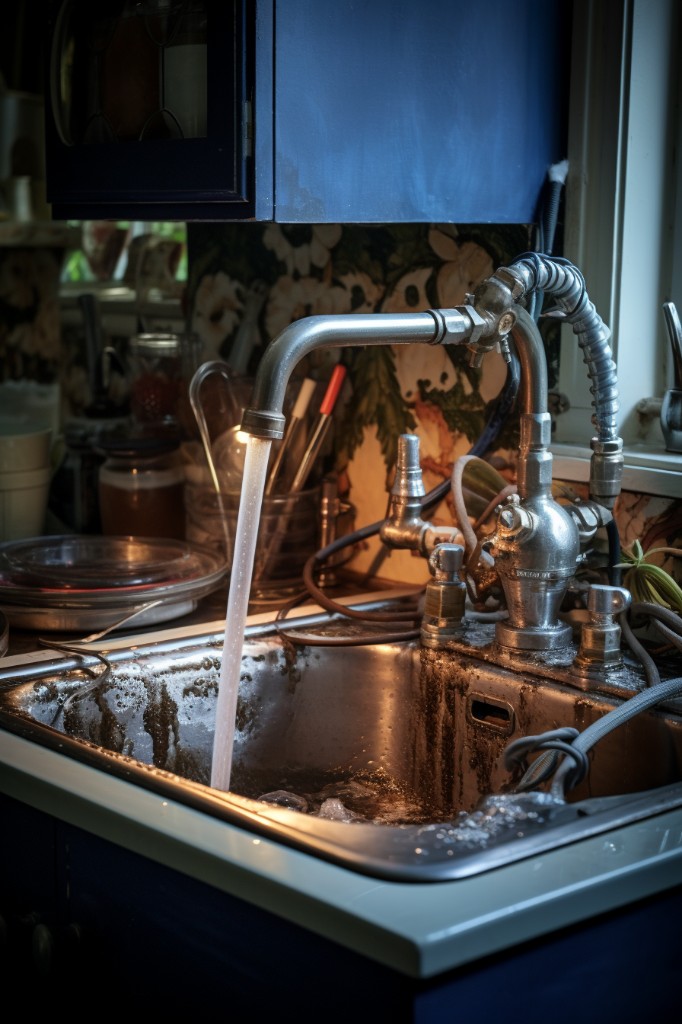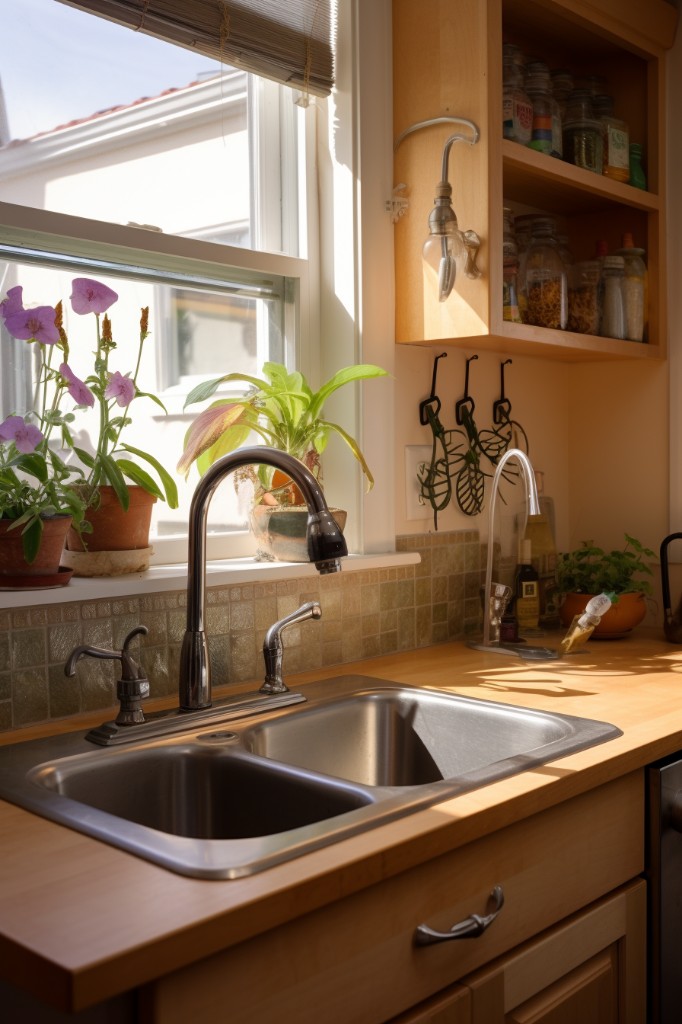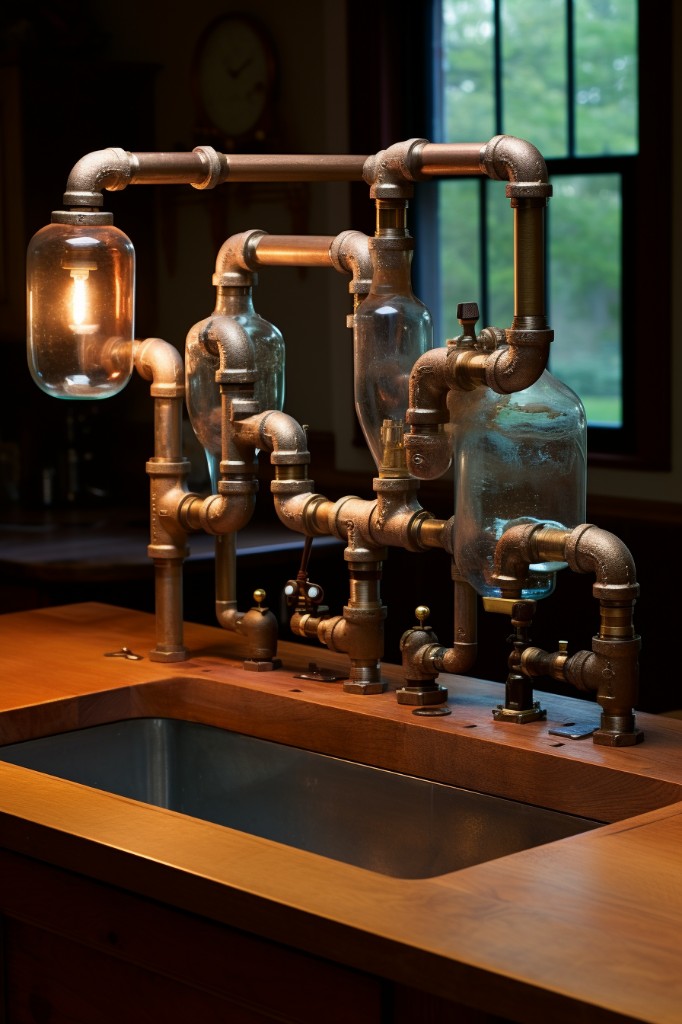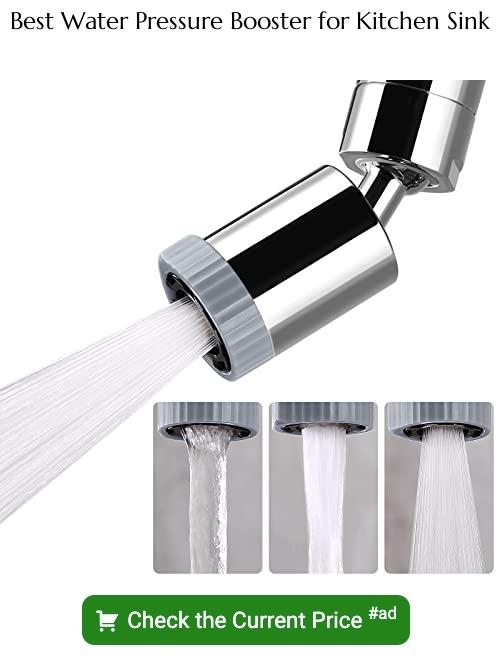Last updated on
Discover the common causes of low water pressure in your kitchen sink and learn how to restore it for a more efficient and enjoyable cooking experience.
Are you tired of your kitchen sink trickling water at a snail’s pace? Low water pressure in the kitchen sink can be frustrating, especially when you’re trying to wash dishes or fill up a pot with water. But before you call a plumber and spend money on repairs, there are several reasons why your kitchen sink may have low water pressure.
In this article, we’ll explore some of the common causes and offer tips on how to fix them. So grab a cup of coffee and let’s dive in!
What's Inside
Understanding Water Pressure

It’s measured in pounds per square inch (PSI) and can vary depending on several factors, including the height of your home, distance from the main water supply line, and size of pipes. In general, a typical household should have a water pressure between 40-60 PSI.
When you turn on a faucet or showerhead in your kitchen sink or bathroom, it creates an opening for pressurized water to flow out. The higher the pressure behind this flow of water means more volume will come out at once.
Signs of Low Water Pressure

Here are some signs that your water pressure may be too low:
1. Slow Flow: If the water coming out of your faucet is barely a trickle or takes forever to fill up a pot, then you likely have low water pressure.
2. Inconsistent Temperature: When there’s not enough hot or cold water flowing through your pipes, it can cause fluctuations in temperature and make showering or washing dishes uncomfortable.
3. Noisy Pipes: If you hear banging sounds when turning on faucets or flushing toilets, this could indicate that there isn’t enough pressure to keep air from getting trapped inside the pipes.
4. Reduced Sprinkler Performance: Your lawn sprinklers may also suffer from reduced performance due to insufficient flow rate caused by low-pressure issues.
Causes of Low Water Pressure

One common cause is a clogged aerator, which is located at the end of your faucet and can become blocked with mineral deposits or debris over time. Another possible culprit could be a malfunctioning shutoff valve that controls water flow to your home’s plumbing system.
Other causes may include pipe leaks, faulty pressure regulators or reducing valves, issues with the water heater or supply line, and problems with whole-house filtration systems or softeners. In some cases, low water pressure may also result from an outdated plumbing system that needs to be replaced.
It’s important to identify the root cause of low water pressure before attempting any repairs so you don’t waste time and money on ineffective solutions.
Inspect Water Valves

The valves control the flow of water into your home and can become clogged or damaged over time, leading to reduced pressure. Start by checking that all shut-off valves are fully open, including those under sinks and behind toilets.
If you find a valve partially closed, turn it counterclockwise until it’s completely open. If this doesn’t solve the problem, try turning off each valve one at a time and then turning them back on again to see if any changes occur in water pressure.
It’s also important to inspect your main shutoff valve located near where your main supply line enters your home. This valve controls all incoming water from outside sources such as municipal supplies or private wells.
Shutoff Valve Malfunction
The shutoff valve controls the flow of water to your sink, and if it’s not fully open or has become clogged with debris, it can restrict water flow. To check for a faulty shutoff valve, locate the valves under your sink and ensure they are fully open by turning them counterclockwise.
If you find that they are already opened but still have low pressure issues, try closing them tightly before reopening them again.
If this doesn’t work or you notice any signs of damage such as rusted parts or leaks around the valves; then replacing these components may be necessary to restore proper function.
Troubleshooting Water Pressure Issues
First, check if the problem is isolated to just one faucet or affects all faucets in your home. If it’s only affecting the kitchen sink, then the issue may be localized and easier to fix.
Next, inspect the aerator on your faucet for any clogs or mineral buildup that could be restricting water flow. Remove it from the spout and clean it with vinegar or a descaling solution.
If cleaning doesn’t solve the problem, then check for leaks in pipes leading up to your kitchen sink. Leaks can cause low water pressure by reducing overall system pressure.
Another possible culprit is a faulty pressure regulator valve that controls incoming water supply into your home. This valve regulates high-pressure municipal supply lines down to safe levels for household use but can malfunction over time due to wear and tear.
Check for Pipe Leaks
Over time, pipes can develop cracks or holes that allow water to escape before it reaches your faucet. This not only reduces the amount of water that comes out but also wastes a significant amount of water and increases your utility bills.
To check for pipe leaks, turn off all faucets and appliances that use water in your home. Then, locate your home’s main shutoff valve and turn it off to stop the flow of incoming water into your house.
Next, inspect all visible pipes under sinks or behind walls for signs of moisture or corrosion. If you notice any dampness around joints or fittings, this could indicate a leaky pipe.
If you suspect there is a hidden leak somewhere in the plumbing system causing low pressure at one specific fixture like kitchen sink then try turning on other fixtures throughout the house while checking if their flow rate changes significantly when compared with normal operation.
Clogged Aerators
The aerator is a small device that screws onto the end of your faucet and mixes air with water to reduce splashing. Over time, mineral deposits can build up inside the aerator, obstructing water flow and reducing pressure.
To fix this issue, you’ll need to remove the aerator from your faucet using pliers or an adjustable wrench. Once removed, soak it in vinegar for several hours or overnight to dissolve any mineral buildup.
Rinse thoroughly with warm water before reattaching it back onto your faucet.
If cleaning doesn’t work or if you notice damage on the screen itself during inspection (such as cracks), consider replacing it altogether instead of trying DIY fixes that may not be effective long-term solutions.
Dealing With Mineral Deposits
These mineral deposits are usually caused by hard water, which contains high levels of minerals such as calcium and magnesium. Over time, these minerals can build up inside the aerator and restrict the flow of water.
To fix this issue, you’ll need to remove the aerator from your kitchen sink faucet and soak it in a solution of equal parts vinegar and warm water for about an hour. This will dissolve any mineral buildup that has accumulated on the aerator.
After soaking it for an hour or so, rinse off any remaining residue with clean running tap water before reattaching it to your faucet head.
Faulty Pressure Regulators
A pressure regulator is a valve that controls the water flow and maintains consistent water pressure throughout your home’s plumbing system. If it malfunctions, it can cause low or high water pressure issues.
To check if your kitchen sink’s low-pressure problem stems from a faulty regulator, you’ll need to locate the device first. It’s usually located near where the main line enters your house or building and looks like a bell-shaped object with an adjustable screw on top.
If you suspect that this component may be causing problems with your kitchen sink’s performance, call in an experienced plumber to inspect and replace it if necessary. Attempting DIY repairs on this part could lead to more significant damage or even injury due to its location within complex plumbing systems.
Faulty Pressure Reducing Valve
This valve, also known as a regulator, controls the water pressure that enters your home from the main supply line. If it’s not functioning correctly, it can reduce the flow of water to your kitchen sink and other fixtures.
To check if this is causing low water pressure in your kitchen sink, locate the regulator near where the main supply line enters into your home. It should be located near or on top of where you see a shut-off valve for incoming cold-water lines.
If you notice any signs of damage or wear and tear on this component such as rusting or leaking around its connections then it may need replacing by an experienced plumber.
Examine the Water Heater
If you have an older model, it may not be able to keep up with the demand for hot water, which can lead to reduced pressure. To check if this is the issue, turn on only the hot tap and see if there’s any difference in pressure compared to when both taps are turned on.
If you notice that your hot water supply is limited or takes longer than usual to heat up, it might be time for a replacement. A new energy-efficient model will not only improve your home’s overall efficiency but also provide better performance and more consistent temperature control.
Examining your water heater can help identify whether it’s causing low-pressure issues in your kitchen sink or elsewhere around the house.
Evaluate Water Supply Line
The main water supply line that brings fresh, clean water into your home can become damaged or clogged over time, leading to reduced flow and pressure. If you suspect this may be the issue, it’s best to call a professional plumber who can evaluate and repair any damage or blockages in the supply line.
In some cases, tree roots growing near underground pipes can also cause damage and reduce water flow. A licensed plumber will have specialized equipment such as video cameras that allow them to inspect pipes for cracks or other issues without having to dig up your yard.
It’s important not to ignore low water pressure in your kitchen sink as it could be an indication of more significant plumbing problems within your home.
Addressing Water Softeners
A water softener works by removing minerals such as calcium and magnesium from hard water, which can cause buildup in pipes and fixtures over time. However, if not maintained properly or if the system is too small for your household’s needs, it can lead to decreased pressure.
To address this issue with a malfunctioning or undersized unit requires professional assistance. A plumber will inspect the system to determine whether there are any clogs or leaks that need fixing.
They may also recommend upgrading to a larger unit that better suits your household’s needs.
It is important to note that while having softer water has its benefits like reducing mineral buildup on appliances and fixtures; however, excessive use of salt-based systems may increase sodium levels in drinking waters which might pose health risks for people with high blood pressure issues.
Whole-house Water Filtration
This type of system filters all the water that enters your home and removes impurities such as chlorine, sediment, and heavy metals. A whole-house filter can also improve the taste and odor of your tap water.
There are several types of whole-house filtration systems available on the market today. Some use activated carbon to remove contaminants while others use reverse osmosis technology for more thorough purification.
The right choice for you will depend on factors such as budget, household size, and specific needs.
While a whole-house filtration system can be an effective way to address low water pressure caused by impurities in your pipes or supply line it is important to note that this solution may not work if there are other underlying issues with plumbing or fixtures within your home’s piping network.
.
Low kitchen sink pressure is often frustrating but it doesn’t have to ruin meal prep time! By understanding what causes low-pressure problems in kitchen sinks – from clogged aerators through faulty regulators – homeowners can take steps towards fixing them themselves before calling out professional help when necessary.
Water Pressure Booster
A booster pump is designed to increase the flow of water through your pipes by increasing the pressure. It’s an effective solution for homes with low municipal water supply or those that rely on well systems.
A typical booster pump consists of a motor, impeller, and controller. The motor drives the impeller which creates suction that draws more water into your home’s plumbing system.
The controller regulates how much power is sent to the motor based on demand.
Before installing a booster pump, it’s important to determine if this is indeed what you need as too much pressure can damage pipes and appliances such as dishwashers or washing machines.
Consulting with a professional plumber will help ensure proper installation and avoid any potential issues down-the-line.
DIY Fixes for Low Water Pressure
One of the first things to check is the aerator on your faucet. Over time, mineral deposits and debris can build up in the aerator and restrict water flow.
Simply unscrew it from the faucet head and clean it with vinegar or a descaling solution.
Another common cause of low water pressure is clogged pipes or valves. If this is suspected, turn off all faucets throughout your home and then turn on one at a time starting with those closest to where the main line enters into your house until you find which one has reduced flow.
You may also want to inspect any shut-off valves leading to appliances like dishwashers or refrigerators as they could be partially closed causing lower than normal pressures.
Maintenance Tips to Avoid Low Pressure
Regular maintenance can help you avoid the inconvenience of low water pressure and save you money on costly repairs. Here are some tips for maintaining good water pressure in your kitchen sink:
1. Clean Your Aerators: Over time, mineral deposits can build up inside the aerator, causing a blockage that restricts water flow.
To prevent this from happening, remove the aerator periodically and clean it with vinegar or a descaling solution.
2. Check for Leaks: Even small leaks can cause significant drops in water pressure over time if left unchecked.
Inspect all pipes under your sink regularly for signs of leakage.
3. Replace Old Pipes: If you have old galvanized steel pipes that are corroded or rusted out, they may be restricting proper flow through them leading to lower pressures at faucets downstream from them.
4. Check Water Valves Regularly: Make sure all valves connected to your plumbing system are fully open; otherwise they will reduce overall system performance by limiting available volume/pressure.
When to Call a Professional Plumber
A licensed plumber has the expertise and tools necessary to diagnose and repair complex plumbing issues that are beyond the scope of a homeowner’s abilities. If you suspect there is a leak or damage to your pipes, it’s best not to attempt repairs yourself as this can lead to further damage or even flooding.
A professional plumber can quickly identify any underlying problems with your plumbing system and provide effective solutions that will restore normal water pressure in no time.
It’s important not to ignore persistent low water pressure as this could indicate more significant issues with your home’s plumbing system. If left unaddressed, these problems could result in costly repairs down the line or even pose health risks due to mold growth from leaks.
FAQ
Can you increase water pressure in kitchen sink?
To increase water pressure in a kitchen sink, one can clean the aerator, rinse the filter, flush the water supply lines, and adjust the shut-off valves.
Why is the water only trickling out of tap?
The water is only trickling out of the tap likely due to a damaged washer, which reduces the water supply and might need replacing.
What are the common causes of low water pressure in a kitchen sink?
Common causes of low water pressure in a kitchen sink include: clogged pipes or aerators, closed shut-off valves, water leaks, and malfunctioning pressure regulators.
How can I troubleshoot and identify the issue causing low water pressure in my kitchen sink?
To troubleshoot and identify the issue causing low water pressure in your kitchen sink, inspect the water valve, aerator, clogged pipes, and pressure regulator.
Are there any recommended tools or methods to fix low water pressure in a kitchen sink?
Recommended tools or methods to fix low water pressure in a kitchen sink include cleaning or replacing the aerator, checking for pipe leaks, and adjusting the shut-off valve.





